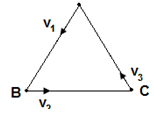Question
Let there are three equal masses situated at the vertices of an equilateral triangle, as shown in figure. Now the particle A starts with a velocity v1 towards line AB, particle B starts with the velocity v2 towards line BC and particle starts with velocity v3 towards line CA. Find the displacement of the centre of mass of the three particles A, B and C after time t. What would it be the displacement of centre of mass if v1=v2=v3?


Answer: Option D
:
D
First we write the three velocities in vectorial form, taking right direction as positive x-axis and upwards as positive y-axis.
→v1=−12v1^i−√32v1^j
→v2=v2^i,→v3=−12v3^i+√32v3^j
Thus the velocity of centre of mass of the system is
→vCM=→v+→v2+→v33
=(v2−12v1−12v3)^i+√32(V3−V1)^j
Which can be written as→vCM=vx^i+vy^j
Δ→r=vxt^i+vxt^j
If v1=v2=v3=v, we have →vCM=0
Therefore, there is no displacement of centre of mass of the system
Was this answer helpful ?
:
D
First we write the three velocities in vectorial form, taking right direction as positive x-axis and upwards as positive y-axis.
→v1=−12v1^i−√32v1^j
→v2=v2^i,→v3=−12v3^i+√32v3^j
Thus the velocity of centre of mass of the system is
→vCM=→v+→v2+→v33
=(v2−12v1−12v3)^i+√32(V3−V1)^j
Which can be written as→vCM=vx^i+vy^j
Δ→r=vxt^i+vxt^j
If v1=v2=v3=v, we have →vCM=0
Therefore, there is no displacement of centre of mass of the system
Was this answer helpful ?


















Submit Solution